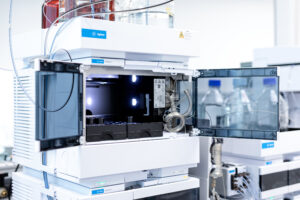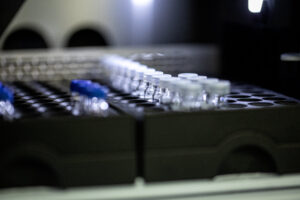From routine analysis through to fully customisable method development and analytical problem-solving projects, we can help with your analytical challenges. Discover our analytical services.
Capabilities
- Waters HClass UPLC with UV, ELSD and MS detection
- Agilent 1290 UHPLC with UV and MS detection
- Thermo Vanquish UHPLC with UV and Charged Aerosol Detection (CAD)
- Waters UPC2 SFC with UV and MS detection
- Agilent Infinity 2 1260 SFC with UV detection
- Agilent 8860 GC with FID
QC via LCMS
When creating compound libraries, it is crucial to know that a compound is correctly identified and pure. We can offer QC purity checks, via UHPLC-MS, from a few samples to several well-plates.

Sample submission is straight forward, and data output is kept as simple as possible, providing as much or as little raw data as the individual client requires.
Experimental Polar Surface Area (EPSA)
Polar surface area (PSA), in conjunction with other descriptors, is used to indicate a molecules permeability. Experimental polar surface area (EPSA) is a high throughput and robust method of measuring PSA. EPSA is especially useful for assessing permeability for beyond rule of five compounds as its value accounts for intramolecular hydrogen bonding. When analysed by SFC using a specialised stationary phase, compounds with a higher EPSA value show greater retention times. Retention time can subsequently be converted into an EPSA value using calibration standards.
ChromLogD
 Log D measurements are used as an indication of lipophilicity for compounds and give a useful insight into the pharmacokinetics and solubility of drug molecules. Whilst Log D values are obtained using time consuming octanol/water shake flask experiments, ChromLog D simulates this equilibrium using lipophilic stationary phase and hydrophilic mobile phase.
Log D measurements are used as an indication of lipophilicity for compounds and give a useful insight into the pharmacokinetics and solubility of drug molecules. Whilst Log D values are obtained using time consuming octanol/water shake flask experiments, ChromLog D simulates this equilibrium using lipophilic stationary phase and hydrophilic mobile phase.
As a result, ChromLog D can be used to provide indicative lipophilicity values at various pH levels with a significantly higher throughput.
Stability Studies
Before it can progress into development, it is crucial to have an understanding of a molecule’s stability. Chemical and chiral stability studies can provide this information. We can adapt our internal protocol for chemical stability studies to match your requirements, assessing different temperatures and pH’s across several time points.
Chiral Screening and Method Development
With so many chiral stationary phases available commercially, it is difficult to know where to start. At Reach we can screen more than 15 stationary phases, in both HPLC and SFC modes. With a range of solvent systems and pH modifiers, we can screen more than 150 conditions to find and develop the optimum method for analysis and/or scale up.
Get in touch to find out more about our analytical services.
EE Determination
Whether you want to check the optical purity of a starting material, monitor a stereoselective reaction or assess final purity, we can return results for EE determinations within two working days of compound receipt. With our extensive chiral screen, we can either develop a method from scratch or follow a literature method or client protocol.
